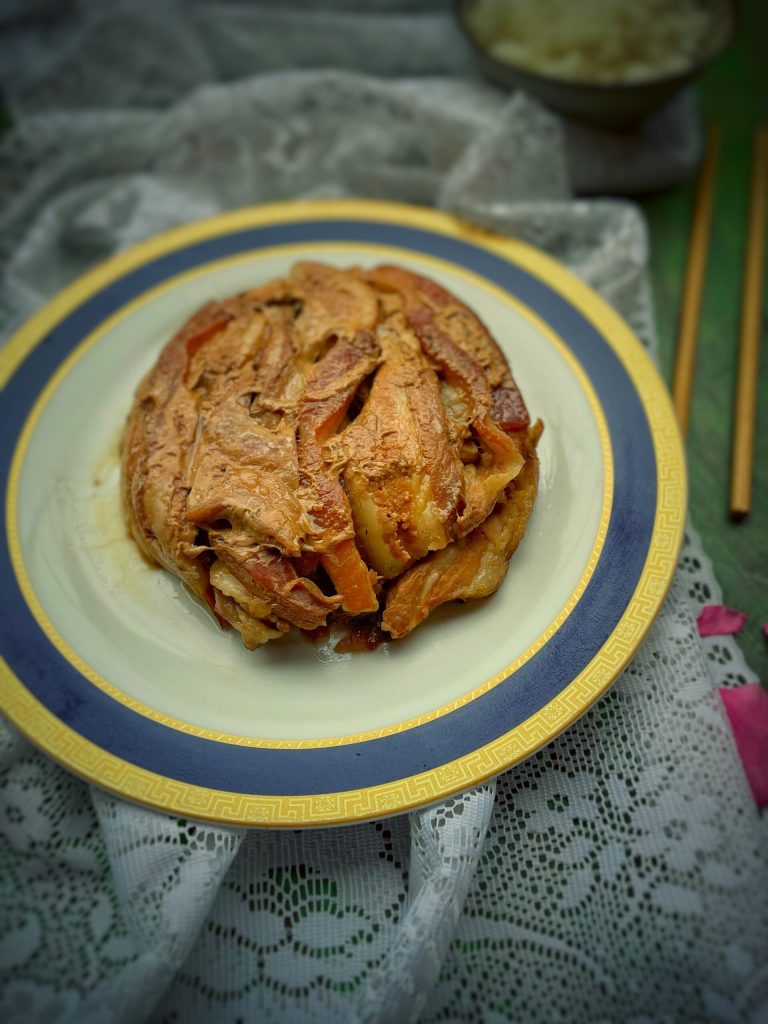The Mei Cai Kou Rou (梅菜扣肉) is a classic dish from Hakka and Cantonese cuisine, made with braised and then steamed pork belly, often prepared during festivals such as Chinese New Year, symbolizing abundance and prosperity.
It is served on a bed of intensely flavored preserved mustard known as Mei Cai 梅菜 and accompanied by rice.
The dried type, typical of Shanghai and Jiangnan cuisine, requires rehydration. The Cantonese version is fresh and can be consumed directly.
There are many variations of Mei Cai Kou Rou in different regions of China. The cooking method and general appearance are similar, but they differ in seasonings.
Some use soy sauce to impart the main flavor, while others add fermented ingredients such as Fu Ru (fermented tofu) or spicy seasonings like Doubanjiang.
Traditional recipes of Mei Cai Kou Rou involve frying the partially cooked pork belly to achieve a wrinkled skin effect, known as “tiger skin” 虎皮.

- Difficulty: Medium
- Rest time: 1 Hour
- Preparation time: 20 Minutes
- Portions: 4 People
- Cooking methods: Boiling, Steaming, Frying
- Cuisine: Chinese
- Seasonality: New Year, All seasons
Ingredients
- 1.76 lbs fresh pork belly (whole with skin)
- 7.05 oz mei cai (or cabbage see below)
- 2 tablespoons dark soy sauce
- 3 tablespoons light soy sauce
- 1 tablespoon rice wine
- 1 tablespoon sugar
- 2 spring onions
- as needed fresh ginger
- as needed white pepper
Tools
- 1 Steamer
- 1 Bowl for steaming
Steps
If using dried mei cai, soak them in water for 1 hour, changing the water 2–3 times to remove excess salt and sand.
Drain, squeeze, and chop finely.Or see questions below.
In a pot, bring water with ginger, spring onions, and rice wine to a boil.
Add the whole pork belly and cook over medium heat for 20 minutes.
Remove and dry well.
Brush the skin with dark soy sauce.
Fry the pork belly in hot oil with the skin side down until golden.
Drain and let cool.
Slice and arrange the pork belly:
Once cooled, slice the pork belly into slices about 0.2 inches thick.
Place the slices in a steam-proof bowl, skin side down.
In a pan, heat a little oil and sauté chopped ginger.
Add the chopped mei cai and cook for a few minutes.
Add light soy sauce, sugar, white pepper, and if desired, star anise, bay leaves, and Sichuan pepper.
Cook until the vegetables are well-flavored.
Remove the bowl from the steam and let rest for a few minutes.
Gently drain any excess liquid and reserve it.
Invert the bowl onto a serving plate, so the pork belly slices are visible on top.
FAQ (Questions and Answers)
What is Mei Cai?
Mei Cai (梅菜), also known as “Chinese pickled vegetable,” is a type of dried and fermented mustard. In English, it can be translated simply as “Chinese pickled vegetable” or more precisely, “dried pickled mustard.” It’s often used in Chinese dishes, especially in Zhejiang cuisine, to flavor stews and other meat-based dishes, such as the famous “Meigan cai kou rou” (梅菜扣肉).
Here are some details on how it is prepared and used:
Preparation:
Mei Cai is made from mustard leaves that are repeatedly steamed and dried until they become reddish-brown and very fragrant.
Usage:
It is often used to flavor stews, particularly paired with pork. It can also be used to fill steamed buns called meigan cai baozi.
Preparation before use:
Before cooking with it, Mei Cai should be soaked in water for several hours and then washed repeatedly to remove salt and other impurities.How can I substitute mei cai (梅菜) – preserved mustard greens; dry or wet, in Italy?
Substituting mei cai (梅菜) in Italy is not easy, but here are some valid alternatives that replicate the texture, taste, and fermentation.
✅ Best substitutes available or creatable:
Dried cabbage or fermented savoy cabbage
Blanch Chinese cabbage or savoy cabbage, squeeze and dry well
Sauté with a bit of soy sauce, sugar, and a pinch of vinegar
Let ferment slightly in a airtight jar 1–2 days at room temperature
Kimchi, well-drained and chopped (without garlic if necessary)
Has acidity and strong flavor, similar to fermented mei cai
Use sparingly not to overpower the taste of the pork
Zha cai or suan cai (Chinese pickled mustard greens)
Available in Asian stores, need slight desalting
Finely chop and sauté before using in the recipe
Broccoli rabe sautéed with soy sauce and sugar
Not fermented, but with a bitter taste and similar texture
❌ To avoid as substitutes:
European sauerkraut → too acidic and thin
Spinach or chard → texture too soft
Raw vegetables → do not have the depth of mei cai

